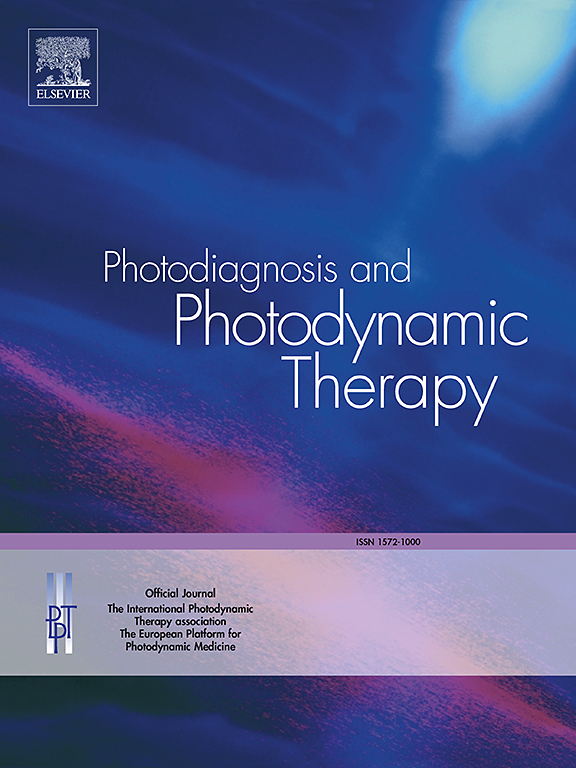抗菌光动力灭活铜绿假单胞菌顽固细胞和生物膜。
IF 3.1
3区 医学
Q2 ONCOLOGY
引用次数: 0
摘要
铜绿假单胞菌是一种难以治疗的人类病原体,迫切需要新的抗菌药物。铜绿假单胞菌以形成生物膜而闻名,这是一种复杂的细菌集合体,嵌在自我生成的保护基质中,增强了对抗生素和免疫系统的抵抗力。在生物膜内,持续性细胞,生长缓慢或生长受阻的细胞亚群,与感染的抵抗和抗生素治疗失败有关。在这里,我们研究了阴离子光敏剂叶绿素(CHL)1单独暴露在红光下以及与机械敏感通道丁酯(BP)激活剂联合暴露对铜绿假单胞菌生长细胞、持久性细胞和生物膜的影响。采用微量肉汤稀释棋盘法进行药敏试验。用丝氨酸羟化酯(SHX)诱导持久性细胞。在光照下,CHL(250µg/ml)和BP(97.12µg/ml)在79 J/cm2下暴露30 min后,生长细胞和持久性细胞的数量分别减少2.2±0.46 log10和1.7±0.15 log10。较高的BP浓度(194.23µg/ml)或较长的暴露时间(158 J/cm2下60分钟)可有效消除约≥99.99%的生长细胞和持久性细胞。共聚焦和透射电镜图像的视觉证据表明CHL和红光的影响,当合并BP时,这种影响会增强。然而,BP的加入并没有增强CHL对生物膜的抑制作用;CHL(500µg/ml)在791 J/cm2时使生物膜活力降低2.6 log10。在黑暗中未观察到毒性。本研究强调了CHL对铜绿假单胞菌的潜在抗菌作用。本文章由计算机程序翻译,如有差异,请以英文原文为准。

Antimicrobial photodynamic inactivation of Pseudomonas aeruginosa persister cells and biofilms
Pseudomonas aeruginosa is a hard-to-treat human pathogen for which new antimicrobial agents are urgently needed. P. aeruginosa is known for forming biofilms, a complex aggregate of bacteria embedded in a self-generated protective matrix that enhance its resistance to antibiotics and the immune system. Within the biofilm, persister cells, sub-populations of slow-growing or growth-arrested cells, are associated with recalcitrance of infections and antibiotic treatment failure. Here, we investigate the influence of the anionic photosensitiser chlorophyllin (CHL)1 exposed to red light alone and in combination with an activator of the mechanosensitive channels butylparaben (BP) on P. aeruginosa growing cells, persister cells, and biofilms. Antimicrobial susceptibility tests were performed using the broth microdilution checkerboard method. Serine hydroxamate (SHX) was used for the induction of persister cells. Under illumination, a combination of CHL (250 µg/ml) and BP (97.12 µg/ml) reduced the number of growing cells and persister cells by log10 and log10, respectively after 30 min of exposure at 79 J/cm2. A higher concentration of BP (194.23 µg/ml) or longer exposure time (60 min at 158 J/cm2) effectively eliminated approximately ≥99.99 % of growing and persister cells. Visual evidence from confocal and TEM images illustrates the influence of CHL and red light, which intensifies when combined with BP. Nevertheless, the addition of BP did not enhance the efficacy of CHL against biofilms; CHL (500 µg/ml) reduced biofilm viability by 2.6 log10 at 791 J/cm2. No toxicity has been observed in darkness. This study highlights the potential antimicrobial effect of CHL against P. aeruginosa.
求助全文
通过发布文献求助,成功后即可免费获取论文全文。
去求助
来源期刊

Photodiagnosis and Photodynamic Therapy
ONCOLOGY-
CiteScore
5.80
自引率
24.20%
发文量
509
审稿时长
50 days
期刊介绍:
Photodiagnosis and Photodynamic Therapy is an international journal for the dissemination of scientific knowledge and clinical developments of Photodiagnosis and Photodynamic Therapy in all medical specialties. The journal publishes original articles, review articles, case presentations, "how-to-do-it" articles, Letters to the Editor, short communications and relevant images with short descriptions. All submitted material is subject to a strict peer-review process.
 求助内容:
求助内容: 应助结果提醒方式:
应助结果提醒方式:


